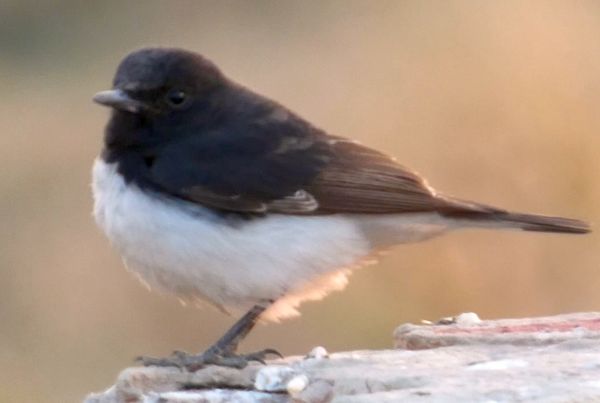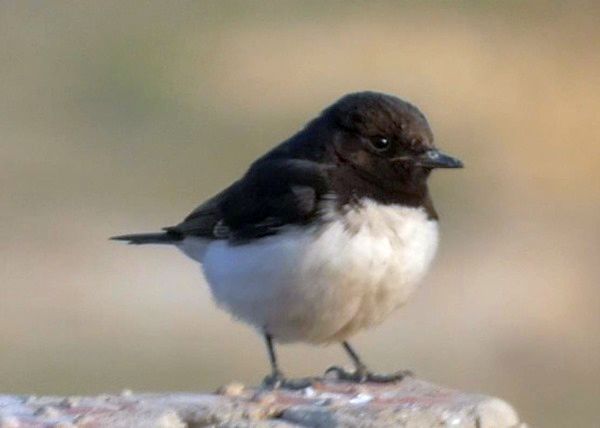Family: Hume’s wheatear (Oenanthe albonigra) is a member of the Old-World flycatcher family Muscicapidae in the genus Oenanthe that a French ornithologist, Louis Vieillot, first described in 1816.
Habitat: A striking Hume’s wheatear is a resident of dry or semidry open land. It habitually glides down and takes the insect back to the same place. It flips its tails regularly. It’s a monotypic species. Its habitats are rocky desert slopes, deep valleys, and foothills; in particular, the stones and debris at the base of desolate hills with little to no vegetation. Also, prefer occasionally dotted with bushes; even stretches of open oak woodland and sparse acacia.

Diet: The food consists of invertebrates, beetles, lizard spiders, ants, grasshoppers, mites, scorpions, snails, and seeds. Moreover, Hume’s wheatear prefers to forage on open ground, utilizing the bound-and-grab technique; occasionally, it will sallie in the air. It also uses the perch-and-pounce technique of elevated perch.
Identification: Hume’s wheatear is a large bird with a dark black head and back, and a pure white breast and belly. Both sexes are identical. The black area doesn’t extend past the throat, while the white area extends further up the back. The juvenile is similar to the adult, but browner with dark mottling on the hood and back, and a less defined breast line below; the female is similar to the male but shorter and less lustrous.
Behavior: Hume’s wheatear inhabits barren hills and rocky slopes, where it forages on the ground for invertebrates.
Vocalizations: The Hume’s Wheatear song is just like a thrush with some sweet and buzzy notes. The call is a harsh “chuk.” It also comprises piercing, short whistles like “triki-treek” or “trooti-trooti-tree,” loud, grating sounds that are frequently repeated quickly, and hushed, alarming “chit-it-it” sounds.
Nesting and Breeding: Nest in a cup-shaped structure made of plant stems and dry leaves, adhered to the substrate using mud and stones, lined with shredded grasses, wool, and feathers, and typically supported by a pebble ramp; nest in a rocky crevice or abandoned building.

Eggs and Incubations: This bird lays 3-5 eggs, rarely 5; pale blue, sporadically reddish-freckled. However, no confirmed information is available regarding incubation and fledging times.
Taxonomy: The British naturalist Allan Octavian Hume first described Hume’s wheatear in 1872 using samples he had taken from rocky slopes in what is now southern Pakistan.
Distribution: Southern Afghanistan, Iran, the far northeast of Iraq, Oman, Pakistan, Qatar, and the United Arab Emirates are among the places where one can see this black-and-white bird.
Movements: Hume’s wheatear is mostly sedentary, with occasional migration uphill and perhaps nomadism.
Other Names: This bird is also known as the Black-headed Wheatear and Hume’s Chat.

Subspecies: There are no subspecies
Similar Species: Hume’s Wheatear is extremely similar to the Variable Wheatear, but Hume’s Wheatear is a little larger and has longer wings and a large bill.
Geographical Realms: Palearctic, Indomalayan and Afrotropical
Status: The population is stable, and it is the least concerned on the IUCN red list.
Altitude: sea-level to mountains, to 2300 meters in southern Iran; 1500–3000 meters in Ladakh, India.
Names in other languages:
-
Danish: Sorthovedet Stenpikker
-
German: Gelbkopf-Steinschmätzer
-
Spanish: Collalba de Hume
-
Italian: Monachella di Hume
-
Dutch: Humes Tapuit
-
Finnish: Munkkitasku
-
Norwegian: Nonnesteinskvett
-
Swedish: Svartvit stenskvätta
-
Catalan: Còlit capnegre
-
Polish: bialorzytka czarnoglowa
-
Turkish: Hume kuyrukkakanı
Read More: Desert Wheatear (Oenanthe deserti)

References:
-
BirdLife International (2024) Species Factsheet: Oenanthe albonigra. https://datazone.birdlife.org/species/factsheet/humes-wheatear-oenanthe-albonigra
-
Article on Wikipedia: https://en.wikipedia.org/wiki/Hume%27s_wheatear
-
Article on Birds of the world: https://birdsoftheworld.org/bow/species/humwhe2/cur/introduction






